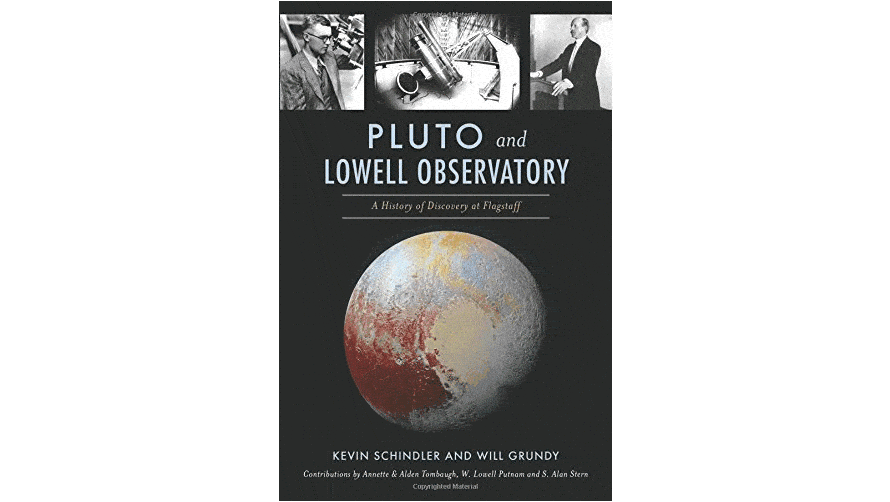Category: Nonfiction
Reviewed by: Casey Suire
Title: Pluto and Lowell Observatory: A History of Discovery at Flagstaff
Authors: Kevin Schindler and Will Grundy
NSS Amazon link for this book
Format: Hardcover/Paperback/Kindle
Pages: 194
Publisher: The History Press
Date: March 2018
Retail price: $34.99/$21.99/$12.99
ISBN: 978-1540228505
This caption on a 1991 postage stamp said it all: “PLUTO NOT YET EXPLORED.” Unlike the other eight planets at the time, Pluto had never been explored by a space probe. That changed on July 14, 2015 when the New Horizons spacecraft made a flyby of Pluto. The following year, the U.S. Postal Service would release new stamps honoring this historic mission. The planet Pluto had finally been explored! Dwarf planet Pluto that is.
Other interesting stories about Pluto are plentiful in the book Pluto and Lowell Observatory: A History of Discovery at Flagstaff. From the very beginning, Lowell Observatory in Flagstaff, Arizona was heavily involved in the exploration of Pluto. The first half of the book details Lowell Observatory’s decades-long quest to find Planet X. The observatory’s founder, famed astronomer Percival Lowell, believed there was another planet lurking beyond Neptune. By the time of his death in 1916, two searches for Planet X were thought to have come up empty. Images of Pluto were actually captured in 1915, but nobody realized it at the time.
Eventually, a third search would begin many years later. In 1930, Lowell astronomer Clyde Tombaugh discovered Pluto. Interestingly, Tombaugh was once told by an older astronomer that his planet-hunting efforts were a waste of time. If there really was another planet, it would have already been found!
The second half of Pluto and Lowell Observatory describes more recent studies of Pluto. After a quiet period where no Pluto work was done for decades, the planet got exciting again. In 1978, astronomer Jim Christy discovered Charon, Pluto’s largest moon. Other moons were later found by the Hubble Space Telescope: Nix, Hydra, Kerberos, and Styx. New findings would ultimately disprove Percival Lowell’s Planet X calculations. Planet X didn’t actually exist. Pluto just happened to be in the same location! The decision by the International Astronomical Union (IAU) to reclassify Pluto as a dwarf planet is also examined. Finally, the story of the New Horizons mission is told toward the end of the book.
One highlight was how Pluto was named. Suggestions from the public were not in short supply. The name “Minerva” was an early favorite, but this was already assigned to an asteroid. Other names referenced figures such as Percival Lowell, Clyde Tombaugh, Babe Ruth, Charles Lindbergh, and King Tut. Following a suggestion by an English schoolgirl named Venetia Burney, the Lowell staff decided on Pluto—the Roman god of the underworld. After all, other planet names came from mythology as well. It also didn’t hurt that the first two letters of Pluto were Percival Lowell’s initials.
Jim Christy’s selection of the name Charon, inspired by his wife Charlene, is possibly the most amusing story in the entire book. At first, it was believed that the name didn’t go along with the mythology theme. That was until Christy opened a dictionary and learned that Charon, coincidently, was a boatman that transported dead souls across the river Styx to the underworld. Problem solved! Pluto and Charon shared the underworld connection in mythology. In the book, there is a humorous photo of the couple playfully looking up “Charon” in a dictionary!
One chapter is dedicated to the affection both Lowell Observatory and the citizens of Flagstaff display toward their favorite small world. At the observatory, there is a donation box where visitors can “vote” with their wallets on what Pluto should be called. The choices are: “Planet”, “Dwarf Planet”, “Other”, and “I don’t care! I just want to support Lowell.” Based on a photo in the book, “Planet” won! One restaurant sells a sushi roll called the Pluto Roll. A coffee house carries Pluto Blend Coffee. There’s a local glass blower that makes Pluto ornaments. On the west side of Flagstaff, there is S Tombaugh Way. Welcome to PlutoTown, USA!
The book is not very long. An enthusiastic reader could probably finish Pluto and Lowell Observatory in a single day. There are dozens of black & white and color photographs. Of course, there are photos taken by New Horizons. The book was written by Lowell historian Kevin Schindler and Will Grundy, a planetary scientist who led the surface composition team for New Horizons. Given the solid credentials of both authors, you can’t go wrong buying this book.
© 2021 Casey Suire
Please use the NSS Amazon Link for all your book and other purchases. It helps NSS and does not cost you a cent! Bookmark this link for ALL your Amazon shopping!
NSS index of over 400 book reviews



















